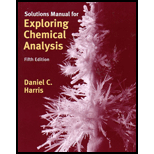
(a)
Interpretation:
Value of
Concept Introduction:
(a)
Explanation of Solution
The compound
The ICE table for concentration of molecules in reaction is as follows:
Concentration of
The expression for equilibrium constant
Rearrange equation (1) for
Here,
Substitute
Therefore, value of
Second equilibrium reaction for dibasic compound
The expression for equilibrium constant
Rearrange equation (5) for
Here,
Substitute
Therefore, value of
The expression used for calculation of
The expression for
Rearrange equation (8) for
Substitute value of
Substitute
Thus,
(b)
Interpretation:
Value of
Concept Introduction:
Refer to part (a).
(b)
Explanation of Solution
The formula to calculate value of
The expression for
Substitute equation (12) in equation (11).
Substitute
The formula to calculate
Rearrange equation (14) for
Substitute 7 for
The reaction for
The expression for equilibrium constant
Rearrange equation (16) for
Substitute
The reaction for
The expression for equilibrium constant
Rearrange equation (18) for
Substitute
Thus,
(c)
Interpretation:
Value of
Concept Introduction:
Refer to part (a).
(c)
Explanation of Solution
The compound
The ICE table for concentration of molecules in reaction is as follows:
Concentration of
The expression for equilibrium constant
Here,
Substitute
Sove above equation for
Therefore, value of
Second equilibrium reaction for hydrolysis of dibasic compound
The expression for equilibrium constant
Rearrange equation (21) for
Substitute
Therefore, value of
The expression used for calculation of
Substitute
Thus, concentration of
Want to see more full solutions like this?
Chapter 11 Solutions
Solutions Manual for Exploring Chemical Analysis
 ChemistryChemistryISBN:9781305957404Author:Steven S. Zumdahl, Susan A. Zumdahl, Donald J. DeCostePublisher:Cengage Learning
ChemistryChemistryISBN:9781305957404Author:Steven S. Zumdahl, Susan A. Zumdahl, Donald J. DeCostePublisher:Cengage Learning ChemistryChemistryISBN:9781259911156Author:Raymond Chang Dr., Jason Overby ProfessorPublisher:McGraw-Hill Education
ChemistryChemistryISBN:9781259911156Author:Raymond Chang Dr., Jason Overby ProfessorPublisher:McGraw-Hill Education Principles of Instrumental AnalysisChemistryISBN:9781305577213Author:Douglas A. Skoog, F. James Holler, Stanley R. CrouchPublisher:Cengage Learning
Principles of Instrumental AnalysisChemistryISBN:9781305577213Author:Douglas A. Skoog, F. James Holler, Stanley R. CrouchPublisher:Cengage Learning Organic ChemistryChemistryISBN:9780078021558Author:Janice Gorzynski Smith Dr.Publisher:McGraw-Hill Education
Organic ChemistryChemistryISBN:9780078021558Author:Janice Gorzynski Smith Dr.Publisher:McGraw-Hill Education Chemistry: Principles and ReactionsChemistryISBN:9781305079373Author:William L. Masterton, Cecile N. HurleyPublisher:Cengage Learning
Chemistry: Principles and ReactionsChemistryISBN:9781305079373Author:William L. Masterton, Cecile N. HurleyPublisher:Cengage Learning Elementary Principles of Chemical Processes, Bind...ChemistryISBN:9781118431221Author:Richard M. Felder, Ronald W. Rousseau, Lisa G. BullardPublisher:WILEY
Elementary Principles of Chemical Processes, Bind...ChemistryISBN:9781118431221Author:Richard M. Felder, Ronald W. Rousseau, Lisa G. BullardPublisher:WILEY





